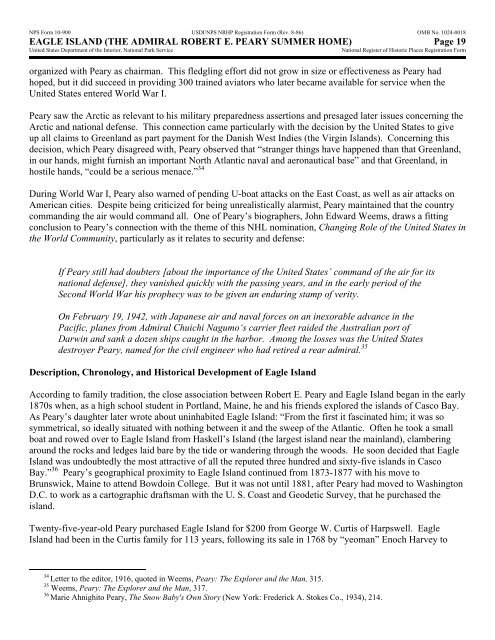Nomination - National Park Service
Nomination - National Park Service
Nomination - National Park Service
Create successful ePaper yourself
Turn your PDF publications into a flip-book with our unique Google optimized e-Paper software.
NPS Form 10-900 USDI/NPS NRHP Registration Form (Rev. 8-86) OMB No. 1024-0018<br />
EAGLE ISLAND (THE ADMIRAL ROBERT E. PEARY SUMMER HOME) Page 19<br />
United States Department of the Interior, <strong>National</strong> <strong>Park</strong> <strong>Service</strong><br />
<strong>National</strong> Register of Historic Places Registration Form<br />
organized with Peary as chairman. This fledgling effort did not grow in size or effectiveness as Peary had<br />
hoped, but it did succeed in providing 300 trained aviators who later became available for service when the<br />
United States entered World War I.<br />
Peary saw the Arctic as relevant to his military preparedness assertions and presaged later issues concerning the<br />
Arctic and national defense. This connection came particularly with the decision by the United States to give<br />
up all claims to Greenland as part payment for the Danish West Indies (the Virgin Islands). Concerning this<br />
decision, which Peary disagreed with, Peary observed that “stranger things have happened than that Greenland,<br />
in our hands, might furnish an important North Atlantic naval and aeronautical base” and that Greenland, in<br />
hostile hands, “could be a serious menace.” 34<br />
During World War I, Peary also warned of pending U-boat attacks on the East Coast, as well as air attacks on<br />
American cities. Despite being criticized for being unrealistically alarmist, Peary maintained that the country<br />
commanding the air would command all. One of Peary’s biographers, John Edward Weems, draws a fitting<br />
conclusion to Peary’s connection with the theme of this NHL nomination, Changing Role of the United States in<br />
the World Community, particularly as it relates to security and defense:<br />
If Peary still had doubters [about the importance of the United States’ command of the air for its<br />
national defense], they vanished quickly with the passing years, and in the early period of the<br />
Second World War his prophecy was to be given an enduring stamp of verity.<br />
On February 19, 1942, with Japanese air and naval forces on an inexorable advance in the<br />
Pacific, planes from Admiral Chuichi Nagumo‘s carrier fleet raided the Australian port of<br />
Darwin and sank a dozen ships caught in the harbor. Among the losses was the United States<br />
destroyer Peary, named for the civil engineer who had retired a rear admiral. 35<br />
Description, Chronology, and Historical Development of Eagle Island<br />
According to family tradition, the close association between Robert E. Peary and Eagle Island began in the early<br />
1870s when, as a high school student in Portland, Maine, he and his friends explored the islands of Casco Bay.<br />
As Peary’s daughter later wrote about uninhabited Eagle Island: “From the first it fascinated him; it was so<br />
symmetrical, so ideally situated with nothing between it and the sweep of the Atlantic. Often he took a small<br />
boat and rowed over to Eagle Island from Haskell’s Island (the largest island near the mainland), clambering<br />
around the rocks and ledges laid bare by the tide or wandering through the woods. He soon decided that Eagle<br />
Island was undoubtedly the most attractive of all the reputed three hundred and sixty-five islands in Casco<br />
Bay.” 36 Peary’s geographical proximity to Eagle Island continued from 1873-1877 with his move to<br />
Brunswick, Maine to attend Bowdoin College. But it was not until 1881, after Peary had moved to Washington<br />
D.C. to work as a cartographic draftsman with the U. S. Coast and Geodetic Survey, that he purchased the<br />
island.<br />
Twenty-five-year-old Peary purchased Eagle Island for $200 from George W. Curtis of Harpswell. Eagle<br />
Island had been in the Curtis family for 113 years, following its sale in 1768 by “yeoman” Enoch Harvey to<br />
34<br />
Letter to the editor, 1916, quoted in Weems, Peary: The Explorer and the Man, 315.<br />
35 Weems, Peary: The Explorer and the Man, 317.<br />
36<br />
Marie Ahnighito Peary, The Snow Baby's Own Story (New York: Frederick A. Stokes Co., 1934), 214.
















